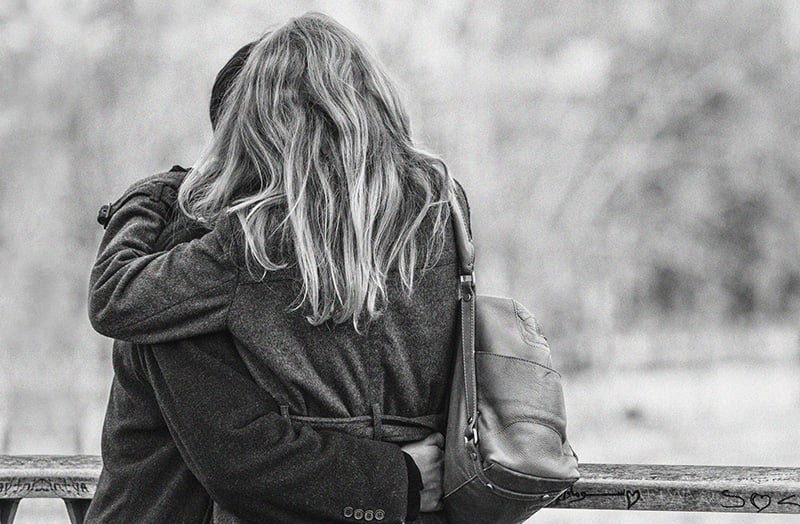The Dark Side of Love

Until recently with the Johnny Depp/Amber Heard trial, this type of relational trauma has not gotten enough attention. I swore to myself that I wouldn’t jump on the divided bandwagon of either Team Johnny or Team Amber, so I’m not. What I am doing, is helping to shed light on the phenomenon of love addiction and traumatic bonding — and how it can quickly devolve into a fatal attraction.
In my humble professional opinion, Johnny and Amber are both wrong. And, they both should have gotten out of the relationship much sooner instead of hitting the replay button on cycles of repetition compulsion. They should have jumped ship before the relationship veered into a near-fatal attraction with millions of dollars owed to each other. They saw the red flags. They saw the relationship going to hell in a handbag. Yet, they both continued engaging in a hopeless battle because this is how trauma bonds work.
Because of this, they have now become the poster children for words like “coercive control”; “trauma bond”; “Borderline”; “obsession” and “domestic abuse”. This is exactly why these types of relationships are so difficult to walk away from: they’re addictive because of the cycles of intermittent positive and negative reinforcement. The relationship goes from the highest of highs to the lowest of lows in the flip of a switch, and then back to more highs.
This identifies traumatically bonded relationships irrespective of whether it’s a romantic relationship, or not.
No, traumatic bonding is not “only” seen in romantic relationships. Trauma bonds begin in our childhood, also as a bi-product of both positive and negative reinforcement. In childhood, we’re learning traumatic bonding based on things like: performance, image, accomplishments, or jumping through hoops to please our parents where the goalposts keep moving. Kids in these situations are learning their value as contingent on pleasing their parents. They become enmeshed with their worth being only as “good enough” as their parents’ approval. In a word: it’s based on narcissistic “value”.
As a psychologist and behavior scientist, I specialize in analyzing human behavior. I can say with certainty that some information I’ve read on traumatic bonding is incorrect. Contrary to what some say, trauma bonds are not based on “reinforcement and punishment”. Speaking in terms of behavior alone, punishment reduces the probability of a behavior recurring— meaning that Johnny, Amber, and millions of other people who’ve found themselves in a traumatic bond should have left sooner if punishment were the culprit.
Reinforcement is what strengthens and maintains behavior. For example, consider any process or substance addiction. They’re maintained by positive reinforcement, or the behavior itself (leveling up in a video game, obtaining the next high with a substance, or feeling the next rush of a shopping spree). Then, negative reinforcement comes into play if a player loses a life or a match against another player, but continues playing to rank up or jump into the next tier. Or, someone with a shopping addiction may feel shame or guilt from shopping and may distract themselves from these negative feelings by turning to an online catalog, only to make another purchase. These patterns identify the cycle.
It’s the same concept as love addiction, which strengthens a traumatic bond and increases the risk of a fatal attraction.
Many of us think that this kind of relationship can’t happen to us. And, we would be naive to assume this. Current statistics report approximately 1:4 women and 1:10 men have experienced the effects of domestic violence in their relationships. An average of 43 million women and 38 million men have experienced psychological aggression (coercive control) by a partner. And nearly $3.6 trillion dollars have been spent on missed work, lost productivity, injuries, and medical services as a result of toxic relational dynamics.
These statistics often don’t include the emotional impact on a person or the probability of getting involved in an adult narcissistic relationship based on adverse childhood experiences. After all, our early experiences shape our beliefs about ourselves and what we deem as ‘acceptable’ in our relationships. If we grew up in a volatile, toxic, or negligent environment, we’re apt to unconsciously seek this out as ‘comfortable’ in our adult lives.
Especially, if we have been conditioned into thinking this is just how relationships are.
Traumatic Bonding, Emotional Addiction and Love Addiction
First,
let’s explain the differences between love addiction, traumatic bonds, and emotional addiction. This can help set the stage for what may have spiraled with Johnny and Amber, as well as to help educate others on risk factors in their own relationships.
Love addiction is defined as pathological behavior associated with a need to be in love, to feel loved, and to be wanted. We typically see “chasing” behavior here, an inability to be alone and cycles of “push-pulls” can define the relationship. Idealization runs high, along with intense emotions, constant rumination or obsessing about their partner, and fantasizing about the relationship.
Love addiction can begin in childhood as a result of neglect, abuse, bullying, or peer rejection. Increased risk factors include: a child not having a positive role model at home, being shunned by peers or bullied, being abused or neglected at home, having no positive adult role model at school or through their community, absentee parents/caregivers, or drug or alcohol addiction at home. Many children who find themselves at risk for later love addiction are literally emotionally starved for love, attention, and connection as children. Many become overly needy and can veer into toxic positivity as a way of trying to fit in or be accepted (which may make them more “awkward” in the eyes of peers) and negatively reinforcing their unmet need for love.
Love addiction falls into one of two common categories: love addicted or relationship addicted. Both types of addictions fall under the umbrella of love addiction. And, both are synonymous with traumatic bonding.
With love addicted persons, they are often more codependent, may get “lost” in fantasies of idealized love, have a hard time being without a relationship, and can spiral into the dark side of love addiction, which can be nihilistic and fatalistic. They can become obsessive, demanding, threatening, and “clingy” or “needy” in the relationship. Other addictions are common, especially with the “lows” seen in traumatic bonding.
With relationship addicted persons, they tend to be more Avoidantly attached, are in love with the “idea” of love (not as much with their partner), and are more easily prone to leave one relationship for another. Their emotions are often fleeting and shallow. Infidelity is common, feelings of boredom or emptiness, and other processes or substance addictions are common to supplement to self-numb and escape. They are more likely to stay in a relationship out of complacency unless there is another relationship already on the sidelines (Peabody, 2005).
Traumatic bonding is the result of all addictive relationships. At the core of traumatic bonding are cycles of intermittent reinforcement, which strengthens a toxic “love” between two people, making it harder to leave, and increasing the risk of jealousy-inducing behavior, self-sabotage, sabotaging the other person, domestic abuse, and increasing the risk of a fatal attraction.
Emotional addiction can be identified as the highs and lows we feel in traumatic bonds, including those based on romantic love addiction. Emotional addiction is not just the good times we get hooked on; we can be just as hooked on the chaos in a relationship, especially when biochemical rushes of dopamine, oxytocin, norepinephrine, and serotonin are in play during the highs, and when the lows cycle around, we release endogenous opioids that begin “numbing” to the toxicity of the cycles.
Love addiction, emotional addiction, and traumatic bonding are an interplay of biochemical, emotional, and behavioral patterns that ‘hook’ us into the addiction.
When it comes to the risk of a toxic relationship turning to worst-case-scenario, there’s no surefire way to gauge this because there are too many variables in play — how long a couple has been together, the history of their relationship, are drugs/alcohol addiction involved, are other addictions involved, how emotionally and mentally stable are they, how old are they, are children involved, do they have a history of other toxic relationships, what is their family history like, and do they have any history of prior intervention.
Yet, there is one key factor that can increase the risk of love addiction occurring, a trauma bond, and a ‘worst case’ scenario.
Addictive Personality. As with most things in our lives, personality runs along a spectrum from adaptive to maladaptive. When it comes to personality type, the “Cluster B” personality disorders are at the highest risk for many addictions, including love addiction, traumatic bonding, and worst-case scenario situations.
For example, you may be in agreement or stark disagreement with the diagnostics used on Ms. Heard and her alleged diagnoses of Borderline Personality Disorder and Histrionic Personality Disorder, both of which fall in the Cluster B disorders.
Opinions aside, let’s look at facts. Based on the DSM-V-TR (2022), Borderline Personality Disorder is based on at least five, of these nine criteria:
A pervasive pattern of instability of interpersonal relationships, self-image, and affects, and marked impulsivity, beginning by early adulthood and present in a variety of contexts, as indicated by five (or more) of the following:
1. Frantic efforts to avoid real or imagined abandonment. (Note: Do not include suicidal or self-mutilating behavior covered in Criterion 5.)
2. A pattern of unstable and intense interpersonal relationships characterized by alternating between extremes of idealization and devaluation.
3. Identity disturbance: markedly and persistently unstable self-image or sense of self.
4. Impulsivity in at least two areas that are potentially self-damaging (e.g., spending, sex, substance abuse, reckless driving, binge eating). (Note: Do not include suicidal or self-mutilating behavior covered in Criterion 5.)
5. Recurrent suicidal behavior, gestures, threats, or self-mutilating behavior.
6. Affective instability due to a marked reactivity of mood (e.g., intense episodic dysphoria, irritability, or anxiety usually lasting a few hours and only rarely more than a few days).
7. Chronic feelings of emptiness.
8. Inappropriate, intense anger or difficulty controlling anger (e.g., frequent displays of temper, constant anger, recurrent physical fights).
9. Transient, stress-related paranoid ideation or severe dissociative symptoms.
So, is she a “Borderline?” Clinically (and diagnostically), her behavior does seem to suggest this. But, this goes directly back to many inconsistencies that happened throughout the trial, including the use of self-report measures which should not have been used. Because self-report measures are just that — based on a person’s own assessment of their symptoms — it can be easy to either “fake good” or “fake bad” on a self-assessment, depending on what Ms. Heard’s motivation may have been.
This is also why tests such as the MMPI-3 and other objective, standardized tests should only be used to assess things like personality constructs or other disorders such as the prevalence of psychopathy. With standardized tests, they are more difficult to “fake good” or “fake bad” because of how they’re designed. I think this was the point that Dr. Shannon Curry was trying to make with regard to Ms. Heard’s scores on a couple of the assessments, and the use of these tests, in general.
Similarly, Dr. David Spiegel suggested that based on Johnny Depp’s behavior, he demonstrated several traits consistent with narcissism including a lack of empathy, a sense of entitlement and jealousy. However, traits themselves are not enough to diagnose someone with a personality disorder, including Narcissistic Personality Disorder (another “Cluster B”), unless they’re displaying five of the nine diagnostic criteria and have been formally assessed using a standardized assessment.
What can be said, is that on trial Mr. Depp mentioned how his drinking got much worse while married to Ms. Heard. This is a red flag commonly seen with love addiction and with addictive personality types in general. When the relationship is on a ‘high’, both partners are hyper-focused on each other and the “good times” which creates the addiction to each other.
When things start taking a downturn, other addictive behaviors are commonly introduced (or increase) as a way of distracting themselves from the relationship problems. For example, process addictions are also common which can include workaholism, shopping, sex, video gaming/gambling, or even spending too much time at the gym as a way of self-numbing.
Final Thoughts…
Traumatic bonds are along a spectrum. On one end are less severe behaviors often seen with minor “push-pull” dynamics. Highs and lows are common, and an inability to walk away from the other person. Arguing, making the other person jealous, infidelity, sabotage, and power struggles are common. On the other end of the spectrum are where fatal attractions happen.
“Some” (and I use this term very cautiously) toxic relationships that are based on trauma bonds don’t devolve this severely into where Johnny and Amber’s relationship wound up. Does it happen? Yes. As a society, we just watched this exact phenomenon unfold publicly. Could their relationship have ended even more tragically? Yes. And, I firmly believe if they had kept going on the path they were on, it may have ended fatally.
I believe that many of us hold blind hope that a bad relationship can fix itself. It can’t. This kind of mindset is what romanticizes traumatic bonds where we’re blinded to just click our heels and proclaim, “There’s no place like home!” while assuming things will be “fine” and work themselves out.
Each relationship has its own patterns and cycles that evolve or devolve, for better or worse. Each relationship goes through its own trials and tribulations, as well. It’s how we work through these downturns that either promote healing or promote traumatic bonding. Not every relationship can (or should) remain intact. Some relationships are better off dissolved and taking the lessons with us for our own growth.
—
This post was previously published on MEDIUM.COM.
***
You Might Also Like These From The Good Men Project
 Compliments Men Want to Hear More Often Compliments Men Want to Hear More Often |
 Relationships Aren’t Easy, But They’re Worth It Relationships Aren’t Easy, But They’re Worth It |
 The One Thing Men Want More Than Sex The One Thing Men Want More Than Sex |
 ..A Man’s Kiss Tells You Everything ..A Man’s Kiss Tells You Everything |
Join The Good Men Project as a Premium Member today.
All Premium Members get to view The Good Men Project with NO ADS.
A $50 annual membership gives you an all access pass. You can be a part of every call, group, class and community.
A $25 annual membership gives you access to one class, one Social Interest group and our online communities.
A $12 annual membership gives you access to our Friday calls with the publisher, our online community.
Register New Account
Log in if you wish to renew an existing subscription.
Need more info? A complete list of benefits is here.
—
Photo credit: Shutterstock
The post The Dark Side of Love appeared first on The Good Men Project.
